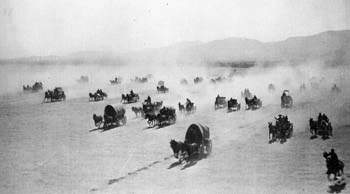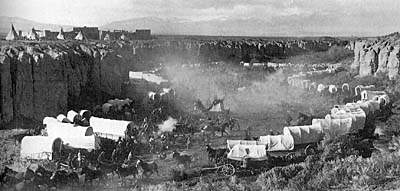|

The land rush scene from John Ford's Three Badmen.
This primal moment in American history -- the birth of modern America -- is also the founding moment of a vast array of contemporary American doctrines. Manifest destiny; rugged individualism; a pre-modern Eden of moral simplicity; a future built on the harmonious union of man and nature -- all four cornerstones of the American psyche, each with their locus on that single moment of expansion and creation. No other period in American history has so frequently been called upon to define and solidify national identity. For this reason alone, the migration West is the single most important event in American history -- an event that is replayed over and over in an affirmation of all that is American, all that is good, bad, and ugly.
The means by which that moment was channeled through American -- and indeed non-American -- communities was many: dime novels, newspaper headlines, comic books, television, film. But of all these mediums perhaps only film truly captured the depth, breadth, and potency of the myth. As Andre Bazin claimed "it is possible that the cinema [is] the only language capable not only of expressing this [myth], but above all of giving it the true aesthetic dimension" (148). Film is "the specifically epic art" (148), he claimed, and is thus most adept at conveying the vastness of the American Wilderness with the frontier town couched untenably on its edge.

A wagon train wanders into trouble in The Covered Wagon.
Shane riding toward the fragile frontier town with the Teton Range mountains rising behind him; The Ringo Kidís shootout with the Plummer Boys on the streets of Lordsburg; Butch and Sundance held frozen forever in a single image of outmoded heroics. These moments have come to encapsulate the grandeur and the glory of the American West. They are not real -- yet they have come to represent the real. The actual West gave way to the mythic West, a Neverland whose landscape was mapped by turn-of-the-century popular media and then held timelessly frozen for prosperity on the silver screen. The purpose of this essay is thus twofold -- firstly to trace this history of the early Western (from the late 1890s until the coming of sound in the late 1920s) and secondly to recast this history in light of the mythology simultaneously proliferating through the early years of the 20th century.
The mythologizing of the American Wild West begins not with film, but with the dime novels and newspaper serials written in the 1860s. Among these volumes were the apocryphal hagiographies of Buffalo Bill Cody, Annie Oakley, Jesse James, Billy the Kid, and many others who would soon constellate the firmament of American mythology. As celebratory chronicles of the untamed West, they constructed a history more in line with folkloric fantasies than actual fact, glorifying the frontier not as it was, but as people would liked it to have been. In 1882, Buffalo Bill would mark the next stage of this process by premiering his Wild West Show. Appealing to the same sensibilities, Cody -- whose trailblazer reputation was built on dime novels -- gathered about him cow-handlers, pony-express riders, sharpshooters, and genuine Sioux Indians to romanticize and commodify the fast-disappearing West. Transforming the frontier into Barnam and Bailey theatrics, the show grew rapidly in popularity and influence. In 1895, with Sitting Bull and Annie Oakley added to the cast-list, Cody attracted six million spectators over a six-month period at the Chicagoís World Fair (Bolton 208). By the time Edison premiered the first means of motion picture presentation in the mid-1890s, the Frontier hardly existed at all -- save only in the wonderland of myth.
page 1 of 8
 
Page 1 The Myth and Pre-History of the Silent Western
Page 2 Prospecting: The Edison Co. and Edwin S. Porter
Page 3 Trail-Blazing: Broncho Billy Anderson, the Genre's First Cowboy
Page 4 Pioneering: Griffith, Ince and the Western as Art and Commerce
Page 5 Frontiersman: William S. Hart and Western Realism
Page 6 Showmanship: Fairbanks, Mix and Jazz Age Cowboy
Page 7 Epic Mythmaking: Cruze and Ford and the End of the Silent Era
Page 8 Conclusion
[Works Cited]
Other Western articles in this issue:
The Western Menu Page
The Western: An Overview
The Silent Western as Mythmaker
Spaghetti Westerns
Western Web Links
| 


